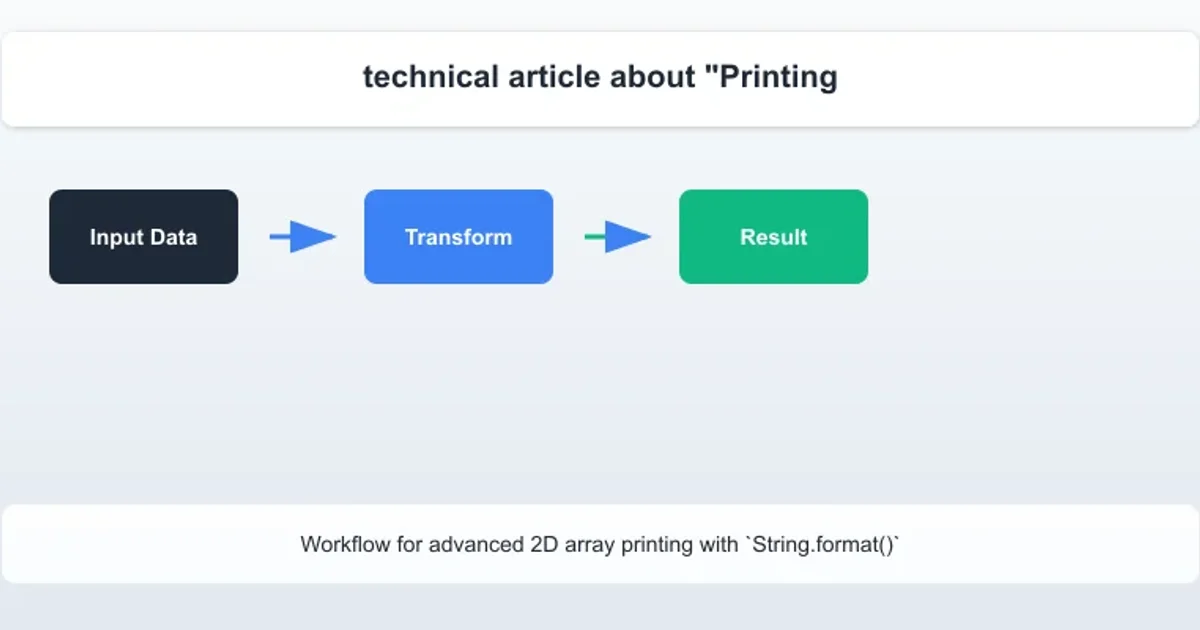Printing a 2d array in Java like a table
Categories:
Printing 2D Arrays in Java: A Guide to Tabular Output

Learn various techniques to effectively print two-dimensional arrays in Java, formatting them as clean, readable tables for better data visualization and debugging.
Two-dimensional arrays are fundamental data structures in Java, often used to represent matrices, grids, or tables. While storing data in a 2D array is straightforward, presenting that data in a human-readable, tabular format can sometimes be a challenge. This article explores different methods to print a 2D array in Java, focusing on techniques that ensure proper alignment and clear presentation, making your output easy to interpret whether for debugging or user display.
Understanding 2D Arrays in Java
Before diving into printing, it's crucial to understand how 2D arrays are structured in Java. A 2D array is essentially an array of arrays. Each element of the outer array is itself an array. This structure allows for 'jagged' arrays where inner arrays can have different lengths, though for tabular printing, we typically work with rectangular arrays where all inner arrays have the same length.
int[][] matrix = {
{10, 20, 30},
{40, 50, 60},
{70, 80, 90}
};
// Accessing an element:
int element = matrix[1][2]; // This would be 60
Declaring and initializing a 2D array in Java
Basic Iteration for Tabular Output
The most common way to print a 2D array is by using nested loops. The outer loop iterates through the rows, and the inner loop iterates through the columns of each row. To achieve a tabular format, you print each element followed by a separator (like a tab \t or spaces) and then move to a new line after each row is complete.
public class ArrayPrinter {
public static void printArrayBasic(int[][] arr) {
for (int i = 0; i < arr.length; i++) { // Iterate through rows
for (int j = 0; j < arr[i].length; j++) { // Iterate through columns
System.out.print(arr[i][j] + "\t"); // Print element and a tab
}
System.out.println(); // Move to the next line after each row
}
}
public static void main(String[] args) {
int[][] matrix = {
{1, 2, 3},
{40, 50, 60},
{7, 8, 900}
};
System.out.println("Basic Tabular Output:");
printArrayBasic(matrix);
}
}
Basic method for printing a 2D array using nested loops and tab separation
\t (tab character) provides basic alignment, it might not perfectly align columns if numbers have vastly different lengths. For precise alignment, consider using String.format().Advanced Formatting with String.format()
For more robust and visually appealing tabular output, especially when dealing with numbers of varying digit counts, String.format() (or System.out.printf()) is the preferred method. This allows you to specify the exact width for each column, ensuring that all numbers align perfectly, creating a clean, column-based table.
public class AdvancedArrayPrinter {
public static void printArrayFormatted(int[][] arr) {
// Determine max width for each column to ensure proper alignment
int[] maxWidths = new int[arr[0].length];
for (int j = 0; j < arr[0].length; j++) {
for (int i = 0; i < arr.length; i++) {
int numLength = String.valueOf(arr[i][j]).length();
if (numLength > maxWidths[j]) {
maxWidths[j] = numLength;
}
}
}
for (int i = 0; i < arr.length; i++) {
for (int j = 0; j < arr[i].length; j++) {
// Use String.format to pad numbers with spaces to match max width
System.out.printf("%" + maxWidths[j] + "d ", arr[i][j]);
}
System.out.println();
}
}
public static void main(String[] args) {
int[][] matrix = {
{1, 20, 300},
{4000, 5, 60},
{70, 800, 9}
};
System.out.println("Formatted Tabular Output:");
printArrayFormatted(matrix);
}
}
Printing a 2D array with precise column alignment using String.format()

Workflow for advanced 2D array printing with String.format()
"%" + maxWidths[j] + "d " format specifier means: "%" starts the specifier, maxWidths[j] is the minimum width, "d" indicates an integer, and the trailing space " " adds a small gap between columns.Using Arrays.deepToString() for Quick Debugging
For quick debugging or when you don't need a perfectly aligned table, Java's Arrays.deepToString() method provides a convenient way to print the contents of a multi-dimensional array. It returns a string representation of the array, including its nested arrays. While not a 'table' in the visual sense, it's incredibly useful for a quick overview.
import java.util.Arrays;
public class DeepToStringExample {
public static void main(String[] args) {
int[][] matrix = {
{10, 20, 30},
{40, 50, 60},
{70, 80, 90}
};
System.out.println("Output using Arrays.deepToString():");
System.out.println(Arrays.deepToString(matrix));
}
}
Using Arrays.deepToString() for a quick string representation of a 2D array
Arrays.deepToString() is excellent for debugging but does not produce a visually aligned table. Its output is a single string with nested array representations, like [[10, 20, 30], [40, 50, 60], [70, 80, 90]].